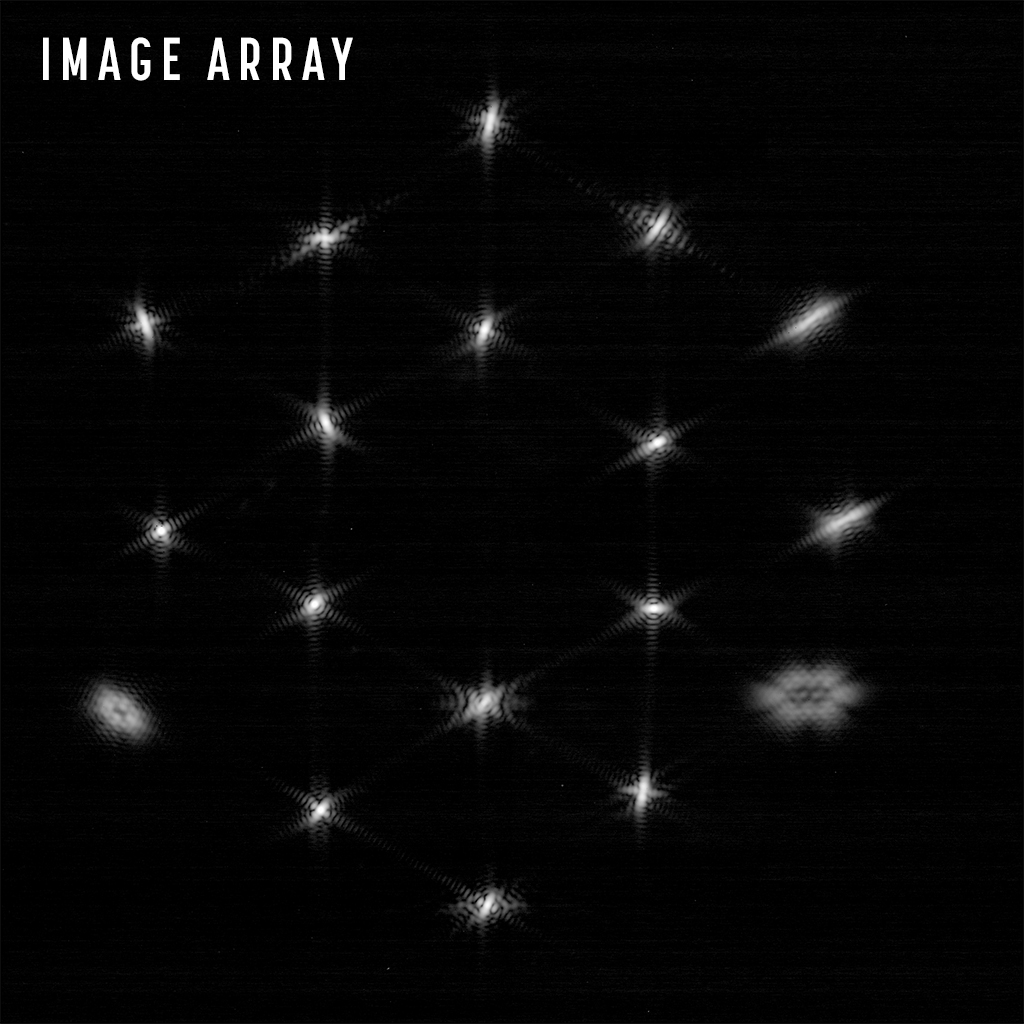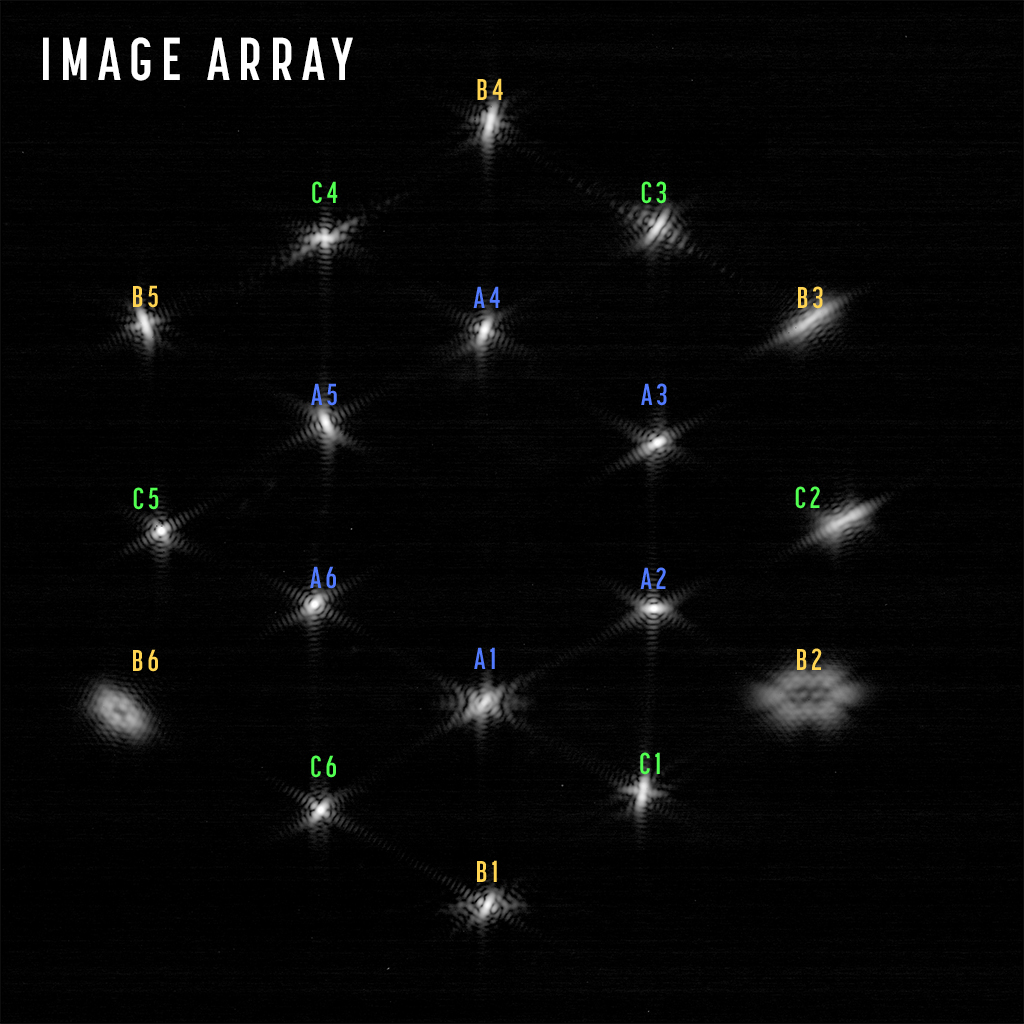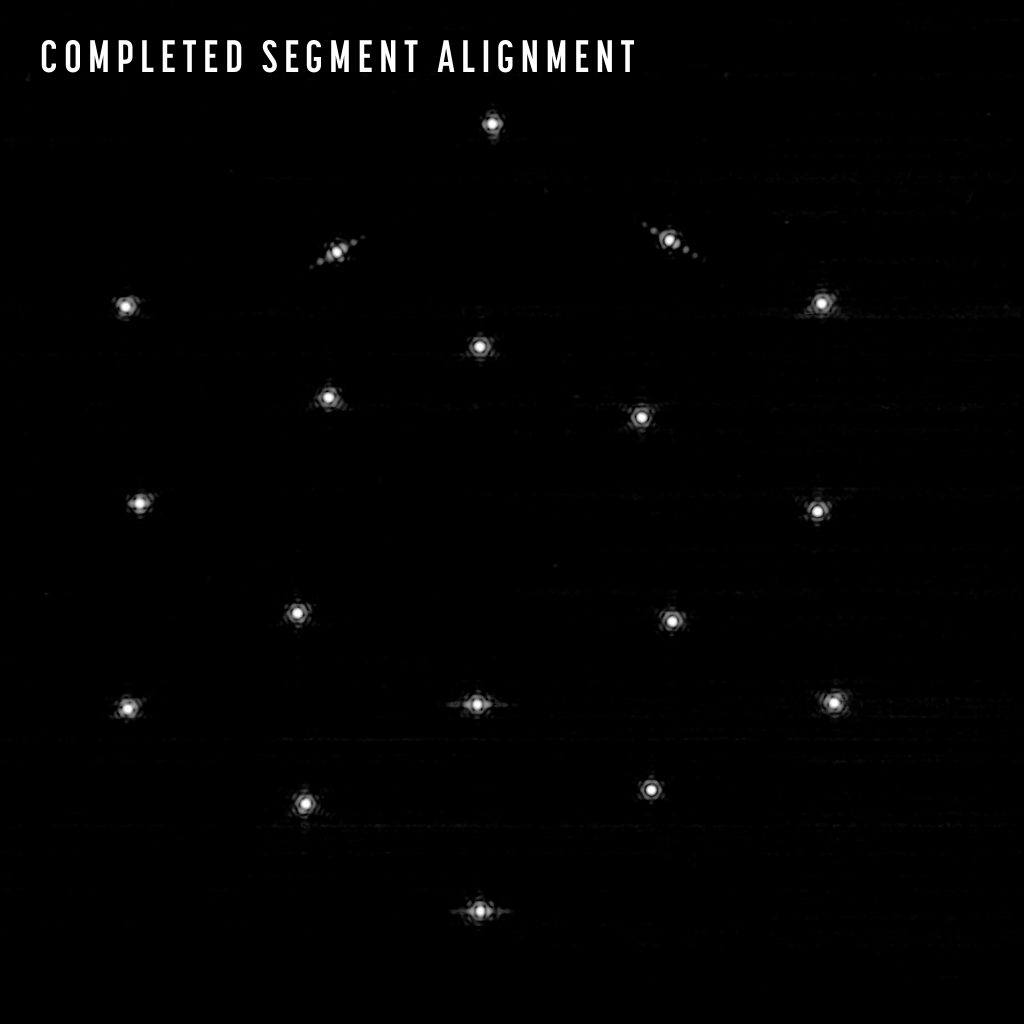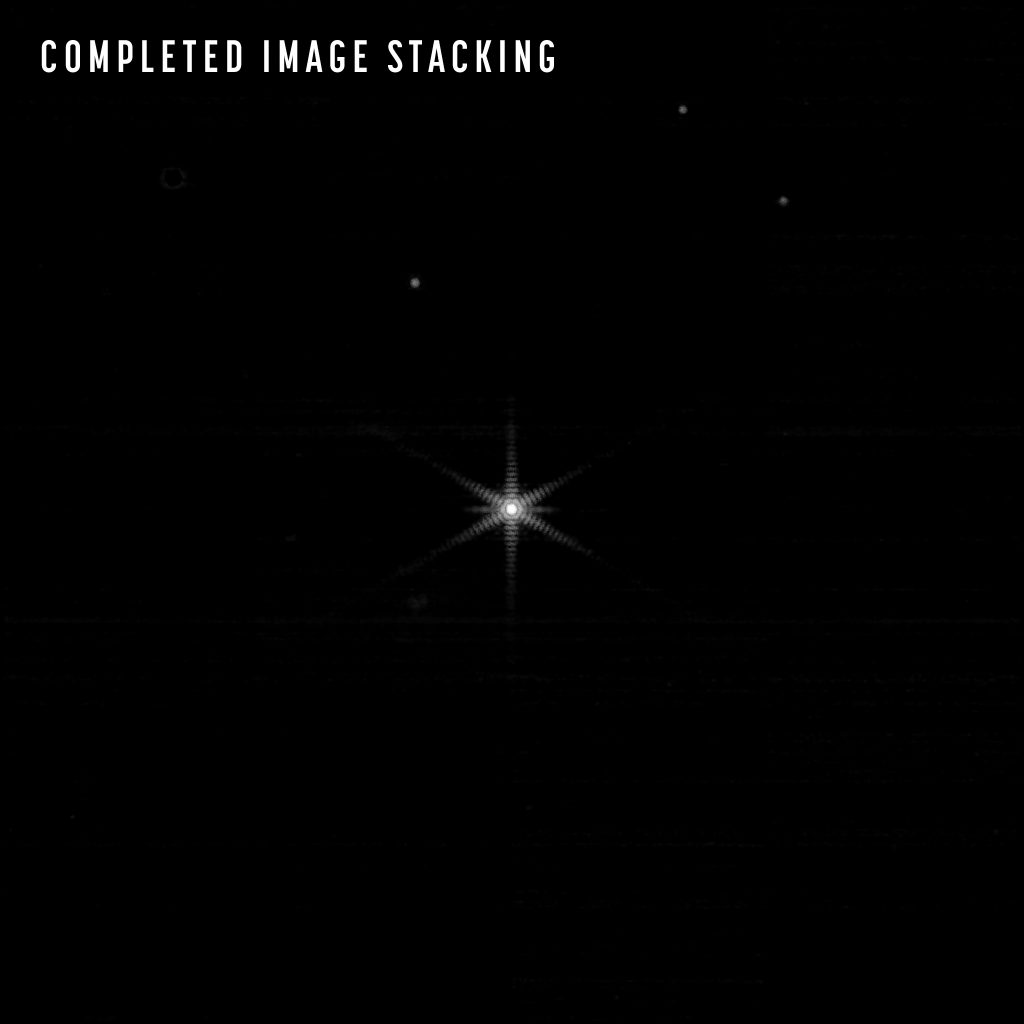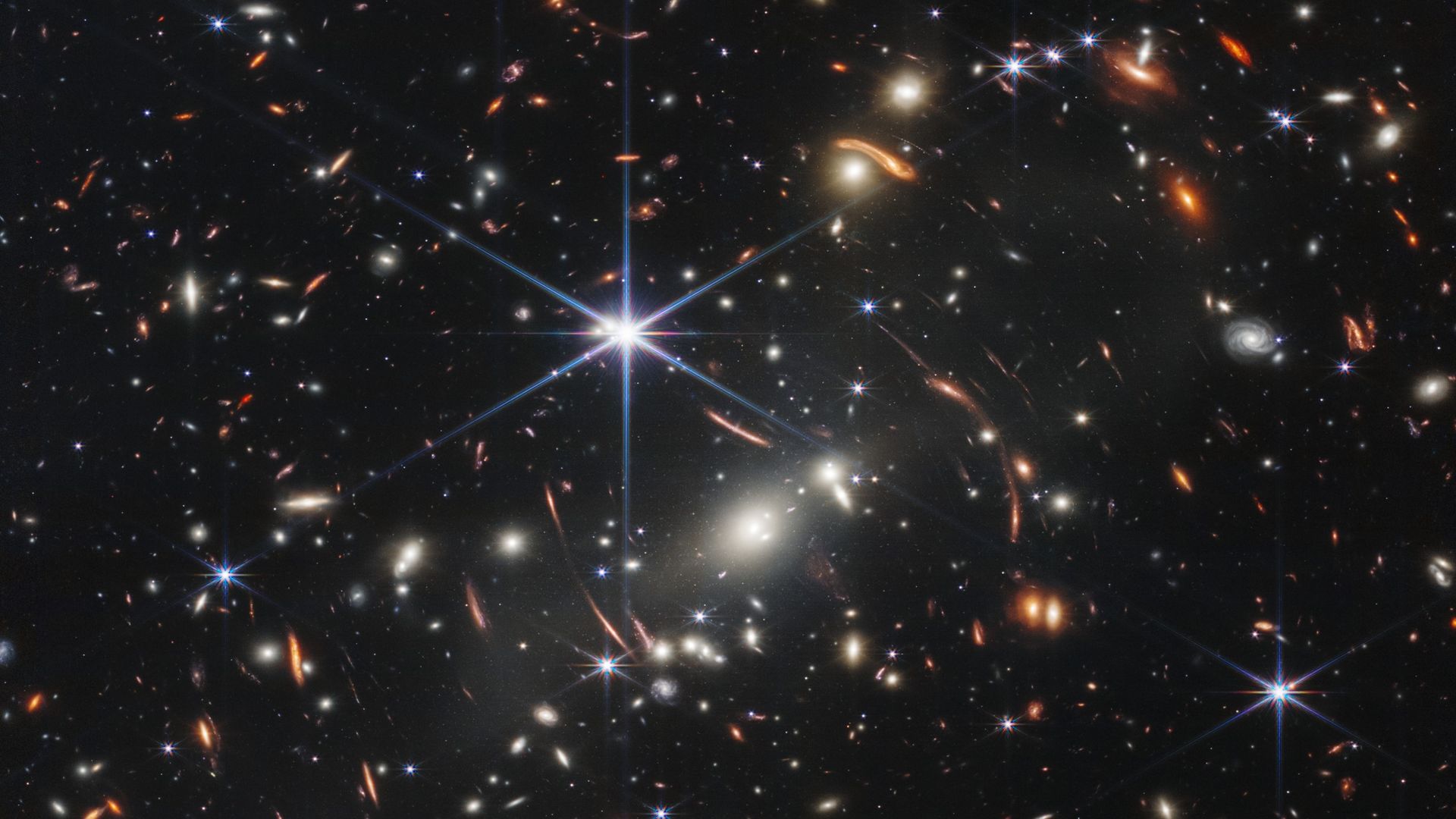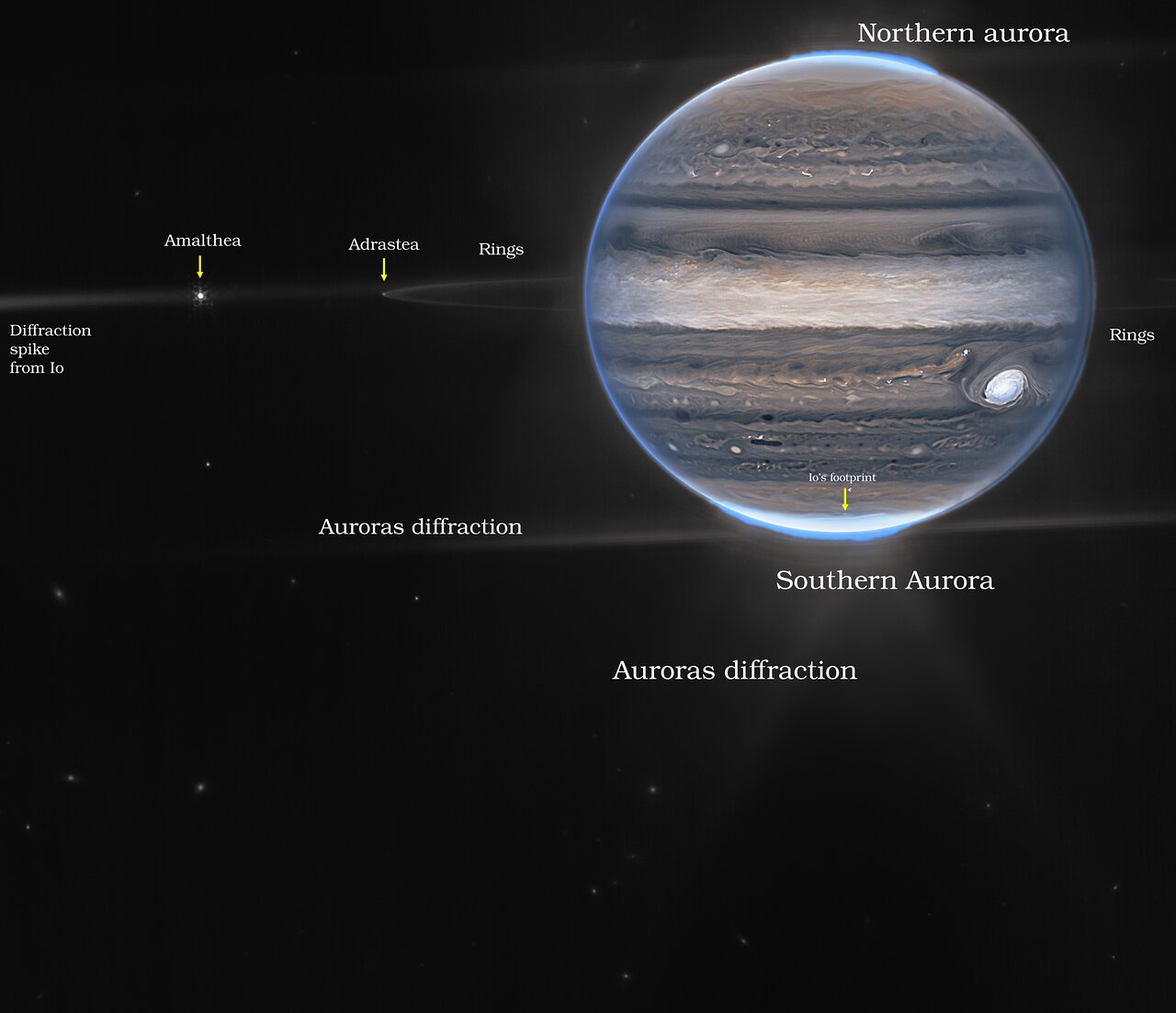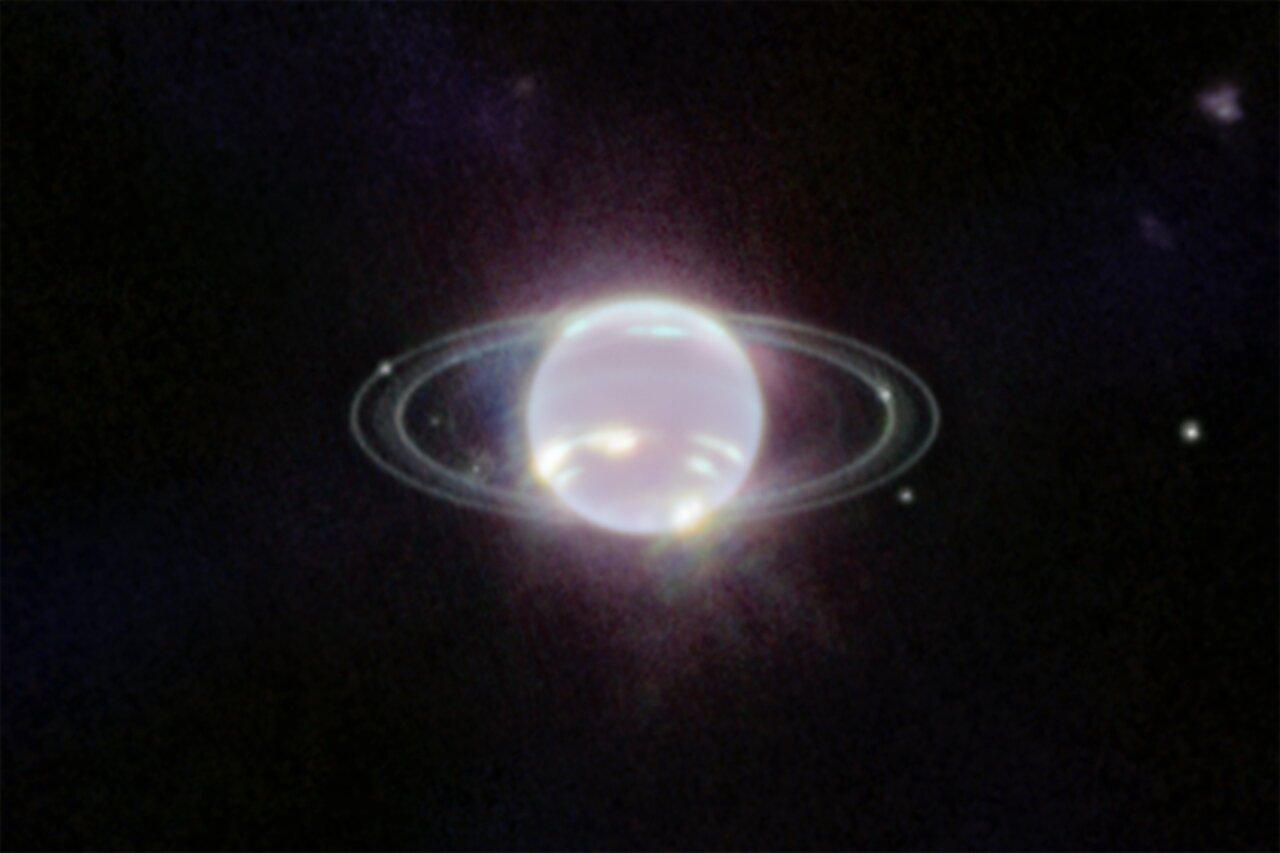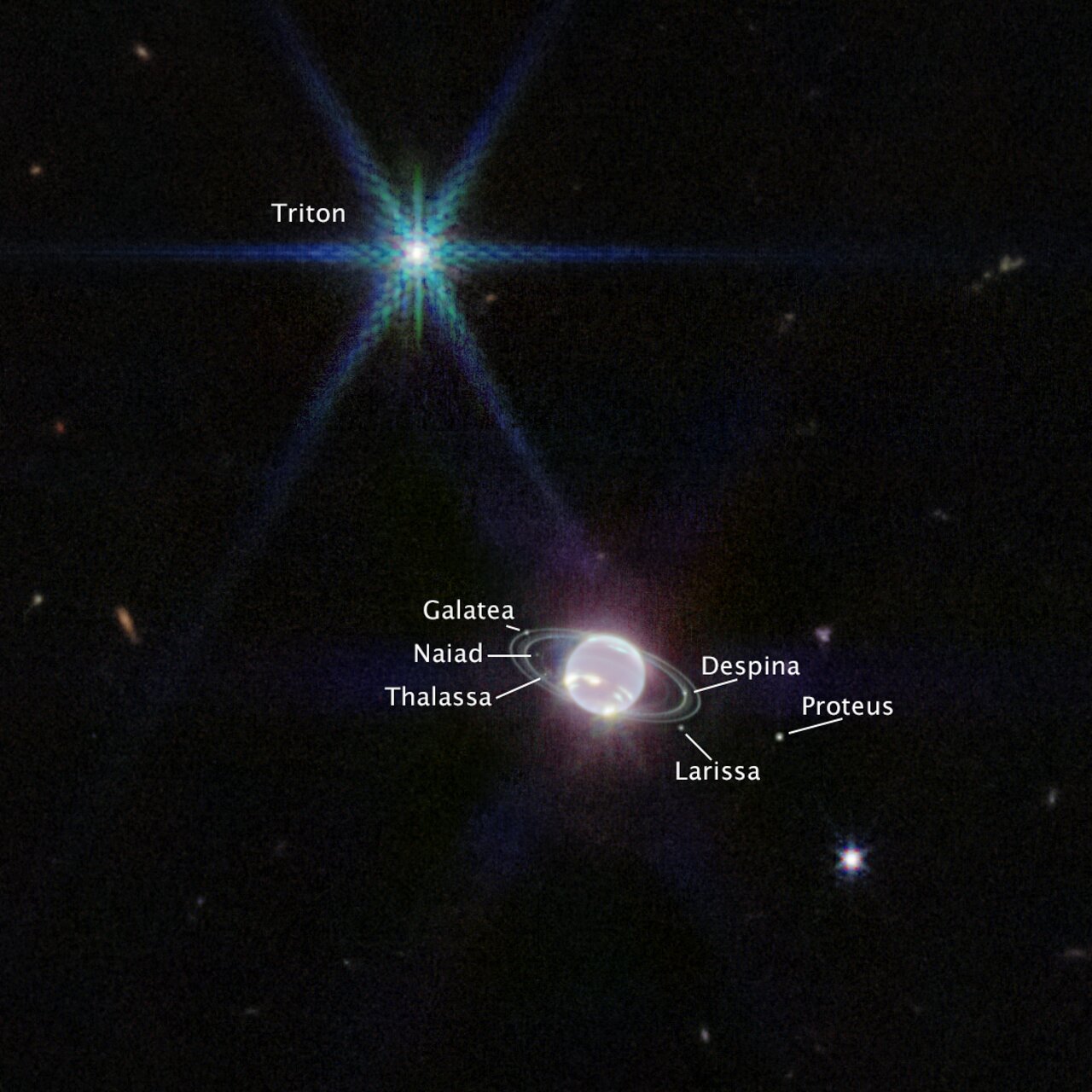That's quite a statement in behalf of a telescope that's still half a year away from first light.Kevin_Hall wrote: ↑Mon Jan 10, 2022 5:18 pm
The Webb Space Telescope has transormned into its final form. Now it is on its way to Lagrange point 2.
JWST has already completed about 80% of the way.
https://twitter.com/NASAWebb/status/147 ... 60609?s=20
Just a quick reminder: the main goal of James Webb Space Telescope is discovering the birth of stars and galaxies, looking for planets to live on. This is the greatest telescope we have ever created.
James Webb Space Telescope (JWST)
- neufer
- Vacationer at Tralfamadore
- Posts: 18805
- Joined: Mon Jan 21, 2008 1:57 pm
- Location: Alexandria, Virginia
Re: James Webb Space Telescope is now fully deployed
Click to play embedded YouTube video.
Art Neuendorffer
-
Kevin_Hall
- Asternaut
- Posts: 8
- Joined: Wed Jan 05, 2022 3:59 pm
Re: James Webb Space Telescope (JWST)
JWST has started the alignment of its 18 golden hexagons. When the setting finishes, the mirrors will be workning as a single focusing instrument.
Whole procedure will take 3 months.
By the way, JWST has already completed 84% of its way to Lagrange point 2. I've also found a cool explanation of JWST by Tyson, highly recommend you to watch it.
https://www.youtube.com/watch?v=ULxl7pfeUL4
Whole procedure will take 3 months.
By the way, JWST has already completed 84% of its way to Lagrange point 2. I've also found a cool explanation of JWST by Tyson, highly recommend you to watch it.
https://www.youtube.com/watch?v=ULxl7pfeUL4
- neufer
- Vacationer at Tralfamadore
- Posts: 18805
- Joined: Mon Jan 21, 2008 1:57 pm
- Location: Alexandria, Virginia
Re: James Webb Space Telescope (JWST)
- Half an inch, half an inch,
Half an inch onward,
All into the valley of L2
Rode the JWST.
https://www.jwst.nasa.gov/content/webbLaunch/whereIsWebb.html?units=metric wrote:
Mirror Segment Deployment Tracker
<<This image tracks the progress of the individual primary mirror segments (A,B,C) and the secondary (SM) mirror as they move upward 12.5mm from their stowed launch position to a deployed state where they are ready for the mirror alignment process. The mirrors move in very small increments over the course of ~10 days to complete their deployment. They move approximately 1mm per day each. For more detail on this process read this blog entry. Each primary mirror segment has an ID which consists of a letter (A,B,C) followed by a number. The letter denotes one of 3 different 'prescriptions' for each group of primary mirror segments. NOTE: Segment A3 and A6 are being moved separately at the end of the process because their position sensors are read out in a different way.>>
Art Neuendorffer
- orin stepanek
- Plutopian
- Posts: 8200
- Joined: Wed Jul 27, 2005 3:41 pm
- Location: Nebraska
Re: James Webb Space Telescope (JWST)
Orin
Smile today; tomorrow's another day!
Smile today; tomorrow's another day!
- neufer
- Vacationer at Tralfamadore
- Posts: 18805
- Joined: Mon Jan 21, 2008 1:57 pm
- Location: Alexandria, Virginia
Re: James Webb Space Telescope (JWST)
https://www.youtube.com/watch?v=pWklR2PBfQU wrote:Click to play embedded YouTube video.
NASA Science Live:Scheduled for 3:00 PM Jan 24, 2022
What’s Next for the James Webb Space Telescope?
<<The past month has been an exciting one for NASA’s James Webb Space Telescope — from launch in tropical French Guiana, to the two-week unfolding of this intricately-packed telescope, the observatory has gone through a huge transformation in space. What’s next for Webb as it cools down over the next five months and looks to #UnfoldTheUniverse?>>
Art Neuendorffer
- neufer
- Vacationer at Tralfamadore
- Posts: 18805
- Joined: Mon Jan 21, 2008 1:57 pm
- Location: Alexandria, Virginia
Re: James Webb Space Telescope (JWST)
https://www.nasa.gov/press-release/nasa-to-discuss-webb-telescope-progress-mirror-alignment wrote:
<<NASA will hold a media teleconference at 11 a.m. EST on Friday, Feb. 11, to share progress made in the early stages of aligning the James Webb Space Telescope’s mirrors. The agency will livestream audio of the teleconference on its website.
Engineers and scientists will review the first weeks of the months-long alignment process and discuss early imagery that shows how the Webb team has identified starlight through each of telescope’s 18 hexagonal mirror segments. NASA will make this imagery available at 10:30 a.m. before the call on the Webb telescope blog.
Teleconference participants include:
The Webb team has begun to fine-tune the telescope using images captured by its Near-Infrared Camera (NIRCam). The early engineering imagery produced during this stage in the process, called “segment image identification,” stitches together more than 1,000 images to form 18 unfocused versions of a single star. This serves as the starting point for gradually aligning Webb’s mirror segments into one precise system.
- Lee Feinberg, Webb optical telescope element manager, NASA’s Goddard Space Flight Center in Greenbelt, Maryland
Marshall Perrin, Webb deputy telescope scientist, Space Telescope Science Institute in Baltimore
Marcia Rieke, principal investigator for the NIRCam instrument and regents professor of astronomy, University of Arizona in Tucson
Following the telescope’s alignment over the next several months, the Webb team will then move on to prepare the instruments for science observations and release the mission's first science images and data in the summer.>>
Art Neuendorffer
Webb Sees Its First Star – 18 Times
Webb Sees Its First Star – 18 Times
NASA | JWST | 2022 Feb 11
NASA | JWST | 2022 Feb 11
The James Webb Space Telescope is nearing completion of the first phase of the months-long process of aligning the observatory’s primary mirror using the Near Infrared Camera (NIRCam) instrument.This image mosaic was created by pointing the telescope at a bright, isolated star in the
constellation Ursa Major known as HD 84406. This star was chosen specifically because it
is easily identifiable and not crowded by other stars of similar brightness, which helps to
reduce background confusion. Each dot within the mosaic is labeled by the corresponding
primary mirror segment that captured it. These initial results closely match expectations
and simulations. Credit: NASAClick to play embedded YouTube video.
The team’s challenge was twofold: confirm that NIRCam was ready to collect light from celestial objects, and then identify starlight from the same star in each of the 18 primary mirror segments. The result is an image mosaic of 18 randomly organized dots of starlight, the product of Webb’s unaligned mirror segments all reflecting light from the same star back at Webb’s secondary mirror and into NIRCam’s detectors.
What looks like a simple image of blurry starlight now becomes the foundation to align and focus the telescope in order for Webb to deliver unprecedented views of the universe this summer. Over the next month or so, the team will gradually adjust the mirror segments until the 18 images become a single star. ...
During the image capturing process that began Feb. 2, Webb was repointed to 156 different positions around the predicted location of the star and generated 1,560 images using NIRCam’s 10 detectors, amounting to 54 gigabytes of raw data. The entire process lasted nearly 25 hours, but notedly the observatory was able to locate the target star in each of its mirror segments within the first six hours and 16 exposures. These images were then stitched together to produce a single, large mosaic that captures the signature of each primary mirror segment in one frame. The images shown here are only a center portion of that larger mosaic, a huge image with over 2 billion pixels. ...
Each unique dot visible in the image mosaic is the same star as imaged by each of Webb’s 18 primary mirror segments, a treasure trove of detail that optics experts and engineers will use to align the entire telescope. This activity determined the post-deployment alignment positions of every mirror segment, which is the critical first step in bringing the entire observatory into a functional alignment for scientific operations. ...
Know the quiet place within your heart and touch the rainbow of possibility; be
alive to the gentle breeze of communication, and please stop being such a jerk. — Garrison Keillor
alive to the gentle breeze of communication, and please stop being such a jerk. — Garrison Keillor
- neufer
- Vacationer at Tralfamadore
- Posts: 18805
- Joined: Mon Jan 21, 2008 1:57 pm
- Location: Alexandria, Virginia
Re: Webb Sees Its First Star – 18 Times
https://en.wikipedia.org/wiki/18_(number) wrote:
<<There are 18 holes on a regulation golf course.Click to play embedded YouTube video.
The Hebrew word for "life" is חי (chai), which has a numerical value of 18. Consequently, the custom has arisen in Jewish circles to give donations and monetary gifts in multiples of 18 as an expression of blessing for long life.
Joseph Heller's novel Catch-22 was originally named Catch-18 because of the Hebrew meaning of the number, but was amended to the published title to avoid confusion with another war novel, Mila 18.
There are 18 chapters in the Bhagavad Gita, which is contained in the Mahabharata, which has 18 books. The Kurukshetra War which the epic depicts, is between 18 armies. The war itself lasts for 18 days. In the other Hindu epic, the Ramayana, the war between Rama and the demons also lasted 18 days.>>
Art Neuendorffer
Webb Team Brings 18 Dots of Starlight into Hexagonal Formation
Webb Team Brings 18 Dots of Starlight into Hexagonal Formation
NASA | JWST | 2022 Feb 19
NASA | JWST | 2022 Feb 19
The Webb team continues to make progress in aligning the observatory’s mirrors. Engineers have completed the first stage in this process, called “Segment Image Identification.” The resulting image shows that the team has moved each of Webb’s 18 primary mirror segments to bring 18 unfocused copies of a single star into a planned hexagonal formation.The image mosaic of 18 randomly positioned copies of the same star, served as the
starting point for the alignment process. To complete the first stage of alignment, the
team moved the primary mirror segments to arrange the dots of starlight into a
hexagonal image array. On the overlay, each dot of starlight is labeled with the
corresponding mirror segment that captured it. Credits: NASA/STScI/J. DePasquale
With the image array complete, the team has now begun the second phase of alignment: “Segment Alignment.” During this stage, the team will correct large positioning errors of the mirror segments and update the alignment of the secondary mirror, making each individual dot of starlight more focused. When this “global alignment” is complete, the team will begin the third phase, called “Image Stacking,” which will bring the 18 spots of light on top of each other.
“We steer the segment dots into this array so that they have the same relative locations as the physical mirrors,” said Matthew Lallo, systems scientist and Telescopes Branch manager at the Space Telescope Science Institute. “During global alignment and Image Stacking, this familiar arrangement gives the wavefront team an intuitive and natural way of visualizing changes in the segment spots in the context of the entire primary mirror. We can now actually watch the primary mirror slowly form into its precise, intended shape!”
Know the quiet place within your heart and touch the rainbow of possibility; be
alive to the gentle breeze of communication, and please stop being such a jerk. — Garrison Keillor
alive to the gentle breeze of communication, and please stop being such a jerk. — Garrison Keillor
Webb Mirror Alignment Continues Successfully
Webb Mirror Alignment Continues Successfully
NASA | JWST | 2022 Feb 25
NASA | JWST | 2022 Feb 25
Webb continues on its path to becoming a focused observatory. The team has successfully worked through the second and third out of seven total phases of mirror alignment. With the completion of these phases, called Segment Alignment and Image Stacking, the team will now begin making smaller adjustments to the positions of Webb’s mirrors.This hexagonal image array captured by the NIRCam instrument shows the progress
made during the Segment Alignment phase, further aligning Webb’s 18 primary
mirror segments and secondary mirror using precise movements commanded from
the ground. During the phase of alignment known as Image Stacking, individual
segment images are moved so they fall precisely at the center of the field to
produce one unified image instead of 18. In this image, all 18 segments are on
top of each other. After future alignment steps, the image will be even sharper.
Credit: NASA/STScI
After moving what were 18 scattered dots of starlight into Webb’s signature hexagonal formation, the team refined each mirror segment’s image by making minor adjustments, while also changing the alignment of Webb’s secondary mirror. The completion of this process, known as Segment Alignment, was a key step prior to overlapping the light from all the mirrors so that they can work in unison.
Once Segment Alignment was achieved, the focused dots reflected by each mirror were then stacked on top of each other, delivering photons of light from each segment to the same location on NIRCam’s sensor. During this process, called Image Stacking, the team activated sets of six mirrors at a time and commanded them to repoint their light to overlap, until all dots of starlight overlapped with each other. ...
Although Image Stacking put all the light from a star in one place on NIRCam’s detector, the mirror segments are still acting as 18 small telescopes rather than one big one. The segments now need to be lined up to each other with an accuracy smaller than the wavelength of the light.
The team is now starting the fourth phase of mirror alignment, known as Coarse Phasing, where NIRCam is used to capture light spectra from 20 separate pairings of mirror segments. This helps the team identify and correct vertical displacement between the mirror segments, or small differences in their heights. This will make the single dot of starlight progressively sharper and more focused in the coming weeks.
Know the quiet place within your heart and touch the rainbow of possibility; be
alive to the gentle breeze of communication, and please stop being such a jerk. — Garrison Keillor
alive to the gentle breeze of communication, and please stop being such a jerk. — Garrison Keillor
Re: James Webb Space Telescope (JWST)
"Test image" of an unremarkable star, for alignment purposes, and Webb has already begun capturing faint galaxies: https://www.space.com/james-webb-space- ... cted-image
- Fred the Cat
- Theoretic Apothekitty
- Posts: 975
- Joined: Mon Feb 22, 2016 4:09 pm
- AKA: Ron
- Location: Eagle, Idaho
Re: James Webb Space Telescope (JWST)
Freddy's Felicity "Only ascertain as a cat box survivor"
NASA: Webb In Full Focus, Ready for Instrument Commissioning
Webb In Full Focus, Ready for Instrument Commissioning
NASA | James Webb Space Telescope | 2022 Apr 28
NASA | James Webb Space Telescope | 2022 Apr 28
Alignment of NASA’s James Webb Space Telescope is now complete. After full review, the observatory has been confirmed to be capable of capturing crisp, well-focused images with each of its four powerful onboard science instruments. Upon completing the seventh and final stage of telescope alignment, the team held a set of key decision meetings and unanimously agreed that Webb is ready to move forward into its next and final series of preparations, known as science instrument commissioning. This process will take about two months before scientific operations begin in the summer.Engineering images of sharply focused stars in the field of view of each instrument demonstrate
that the telescope is fully aligned and in focus. For this test, Webb pointed at part of the Large
Magellanic Cloud, a small satellite galaxy of the Milky Way, providing a dense field of hundreds
of thousands of stars across all the observatory’s sensors. The sizes and positions of the images
shown here depict the relative arrangement of each of Webb’s instruments in the telescope’s
focal plane, each pointing at a slightly offset part of the sky relative to one another. Webb’s three
imaging instruments are NIRCam (images shown here at a wavelength of 2 microns), NIRISS
(image shown here at 1.5 microns), and MIRI (shown at 7.7 microns, a longer wavelength
revealing emission from interstellar clouds as well as starlight). NIRSpec is a spectrograph rather
than imager but can take images, such as the 1.1 micron image shown here, for calibrations and
target acquisition. The dark regions visible in parts of the NIRSpec data are due to structures of
its microshutter array, which has several hundred thousand controllable shutters that can be
opened or shut to select which light is sent into the spectrograph. Lastly, Webb’s Fine Guidance
Sensor tracks guide stars to point the observatory accurately and precisely; its two sensors are not
generally used for scientific imaging but can take calibration images such as those shown here.
This image data is used not just to assess image sharpness but also to precisely measure and
calibrate subtle image distortions and alignments between sensors as part of Webb’s overall
instrument calibration process. Credit: NASA/STScI
The alignment of the telescope across all of Webb’s instruments can be seen in a series of images that captures the observatory’s full field of view. ...
The optical performance of the telescope continues to be better than the engineering team’s most optimistic predictions. Webb’s mirrors are now directing fully focused light collected from space down into each instrument, and each instrument is successfully capturing images with the light being delivered to them. The image quality delivered to all instruments is “diffraction-limited,” meaning that the fineness of detail that can be seen is as good as physically possible given the size of the telescope. From this point forward the only changes to the mirrors will be very small, periodic adjustments to the primary mirror segments. ...
Now, the Webb team will turn its attention to science instrument commissioning. Each instrument is a highly sophisticated set of detectors equipped with unique lenses, masks, filters, and customized equipment that helps it perform the science it was designed to achieve. The specialized characteristics of these instruments will be configured and operated in various combinations during the instrument commissioning phase to fully confirm their readiness for science. ...
Though telescope alignment is complete, some telescope calibration activities remain: As part of scientific instrument commissioning, the telescope will be commanded to point to different areas in the sky where the total amount of solar radiation hitting the observatory will vary to confirm thermal stability when changing targets. Furthermore, ongoing maintenance observations every two days will monitor the mirror alignment and, when needed, apply corrections to keep the mirrors in their aligned locations.
Know the quiet place within your heart and touch the rainbow of possibility; be
alive to the gentle breeze of communication, and please stop being such a jerk. — Garrison Keillor
alive to the gentle breeze of communication, and please stop being such a jerk. — Garrison Keillor
- orin stepanek
- Plutopian
- Posts: 8200
- Joined: Wed Jul 27, 2005 3:41 pm
- Location: Nebraska
Re: James Webb Space Telescope (JWST)
For all of us waiting; here is the countdown! 
https://www.jwst.nasa.gov/content/webbL ... tdown.html
https://www.jwst.nasa.gov/content/webbL ... tdown.html
Orin
Smile today; tomorrow's another day!
Smile today; tomorrow's another day!
Webb Telescope's First Images of Unseen Universe
Webb Telescope's First Images of Unseen Universe
NASA | GSFC | STScI | Webb Telescope | 2022 Jul 12
First Images Shared From Webb Telescope Reveal Unseen Universe
ESA Webb Organizational Release | 2022 Jul 12
viewtopic.php?p=324130#p324130
NASA | GSFC | STScI | Webb Telescope | 2022 Jul 12
The dawn of a new era in astronomy has begun as the world gets its first look at the full capabilities of NASA’s James Webb Space Telescope, a partnership with ESA (European Space Agency) and CSA (Canadian Space Agency). All of the telescope’s first full-color images and spectroscopic data, which uncover a collection of cosmic features that have remained elusive until now, released Tuesday, are available at: nasa.gov/webbfirstimages ...
...
- SMACS 0723: Webb has delivered the deepest and sharpest infrared image of the distant universe so far – and in only 12.5 hours. This new image, a color composite of multiple exposures each about two hours long, is approximately the size of a grain of sand held at arm’s length. This deep field uses a lensing galaxy cluster to find some of the most distant galaxies ever detected. This image only scratches the surface of Webb’s capabilities in studying deep fields and tracing galaxies back to the beginning of cosmic time.
[img3][/img3]- WASP-96b (spectrum): Webb’s detailed observation of this hot, puffy planet outside our solar system reveals the clear signature of water, along with evidence of haze and clouds that previous studies of this planet did not detect. With Webb’s first detection of water in the atmosphere of an exoplanet, it will now set out to study hundreds of other systems to understand what other planetary atmospheres are made of.
- Southern Ring Nebula: This planetary nebula, an expanding cloud of gas that surrounds a dying star, is approximately 2,000 light years away. Here, Webb’s powerful infrared eyes bring a second dying star into full view for the first time. From birth to death as a planetary nebula, Webb can explore the expelling shells of dust and gas of aging stars that may one day become a new star or planet.
- Stephan’s Quintet: Webb’s view of this compact group of galaxies, located in the constellation Pegasus, pierced through the shroud of dust surrounding the center of one galaxy, to reveal the velocity and composition of the gas near its supermassive black hole. Now, scientists can get a rare look, in unprecedented detail, at how interacting galaxies are triggering star formation in each other and how the gas in these galaxies is being disturbed.
- Carina Nebula: Webb’s look at the ‘Cosmic Cliffs’ in the Carina Nebula unveils the earliest, rapid phases of star formation that were previously hidden. Looking at this star-forming region in the southern constellation Carina, as well as others like it, Webb can see newly forming stars and study the gas and dust that made them.
First Images Shared From Webb Telescope Reveal Unseen Universe
ESA Webb Organizational Release | 2022 Jul 12
Highly Anticipated Observations Hint at Treasure Trove of Discoveries to Come
The dawn of a new era in astronomy has begun as the world gets its first look at the full capabilities of the NASA/ESA/CSA James Webb Space Telescope. The telescope’s first full-colour images and spectroscopic data, which uncover a spectacular collection of cosmic features that have remained elusive until now, were released today.
...
- SMACS 0723: Webb has delivered the deepest and sharpest infrared image of the distant Universe so far – and in only 12.5 hours. This new image, a color composite of multiple exposures each about two hours long, is approximately the size of a grain of sand held at arm’s length. This deep field uses a lensing galaxy cluster to find some of the most distant galaxies ever detected. This image only scratches the surface of Webb’s capabilities in studying deep fields and tracing galaxies back to the beginning of cosmic time.
WASP-96b: Webb’s detailed observation of this hot, puffy planet outside our solar system reveals the clear signature of water, along with evidence of haze and clouds that previous studies of this planet did not detect. With Webb’s first detection of water in the atmosphere of an exoplanet, it will now set out to study hundreds of other systems to understand what other planetary atmospheres are made of.
Southern Ring: This planetary nebula, an expanding cloud of gas that surrounds a dying star, is approximately 2,000 light years away. Here, Webb’s powerful infrared eyes bring a second dying star into full view for the first time. From birth to death as a planetary nebula, Webb can explore the expelling shells of dust and gas of aging stars that may one day become a new star or planet.
Stephan’s Quintet: Webb’s view of this compact group of galaxies, located in the constellation Pegasus, pierced through the shroud of dust surrounding the center of one galaxy, to reveal the velocity and composition of the gas near its supermassive black hole. Now, scientists can get a rare look, in unprecedented detail, at how interacting galaxies are triggering star formation in each other and how the gas in these galaxies is being disturbed.
Carina Nebula: Webb’s look at the ‘Cosmic Cliffs’ in the Carina Nebula unveils the earliest, rapid phases of star formation that were previously hidden. Looking at this star-forming region in the southern constellation Carina, as well as others like it, Webb can see newly forming stars and study the gas and dust that made them.
viewtopic.php?p=324130#p324130
Know the quiet place within your heart and touch the rainbow of possibility; be
alive to the gentle breeze of communication, and please stop being such a jerk. — Garrison Keillor
alive to the gentle breeze of communication, and please stop being such a jerk. — Garrison Keillor
How James Webb Space Telescope Data Has Revealed Surprises
by Lisa Grossman
The first image contains a galaxy cluster’s past and recent star birth in more remote galaxies.
Link: Science News
The first image contains a galaxy cluster’s past and recent star birth in more remote galaxies.
Link: Science News
Webb Captures Stellar Gymnastics in The Cartwheel Galaxy
Webb Captures Stellar Gymnastics in The Cartwheel Galaxy
NASA | GSFC | STScI | Webb | ESA Space Science | ESA Webb | 2022 Aug 02
NASA | GSFC | STScI | Webb | ESA Space Science | ESA Webb | 2022 Aug 02
The Cartwheel Galaxy, a rare ring galaxy once shrouded in dust and mystery, has been unveiled by the imaging capabilities of the NASA/ESA/CSA James Webb Space Telescope. The galaxy, which formed as a result of a collision between a large spiral galaxy and another smaller galaxy, not only retained a lot of its spiral character, but has also experienced massive changes throughout its structure. Webb’s high-precision instruments resolved individual stars and star-forming regions within the Cartwheel, and revealed the behaviour of the black hole within its galactic centre. These new details provide a renewed understanding of a galaxy in the midst of a slow transformation.
The NASA/ESA/CSA James Webb Space Telescope has peered into the chaos of the Cartwheel Galaxy, revealing new details about star formation and the galaxy’s central black hole. Webb’s powerful infrared gaze produced this detailed image of the Cartwheel and two smaller companion galaxies against a backdrop of many other galaxies. This image provides a new view of how the Cartwheel Galaxy has changed over billions of years.
The Cartwheel Galaxy, located about 500 million light-years away in the Sculptor constellation, is a rare sight. Its appearance, much like that of the wheel of a wagon, is the result of an intense event – a high-speed collision between a large spiral galaxy and a smaller galaxy not visible in this image. Collisions of galactic proportions cause a cascade of different, smaller events between the galaxies involved; the Cartwheel is no exception.
The collision most notably affected the galaxy’s shape and structure. The Cartwheel Galaxy sports two rings — a bright inner ring and a surrounding, colourful ring. These two rings expand outwards from the centre of the collision, like ripples in a pond after a stone is tossed into it. Because of these distinctive features, astronomers call this a “ring galaxy,” a structure less common than spiral galaxies like our Milky Way.
The bright core contains a tremendous amount of hot dust with the brightest areas being the home to gigantic young star clusters. On the other hand, the outer ring, which has expanded for about 440 million years, is dominated by star formation and supernovas. As this ring expands, it ploughs into surrounding gas and triggers star formation. ...
Know the quiet place within your heart and touch the rainbow of possibility; be
alive to the gentle breeze of communication, and please stop being such a jerk. — Garrison Keillor
alive to the gentle breeze of communication, and please stop being such a jerk. — Garrison Keillor
- orin stepanek
- Plutopian
- Posts: 8200
- Joined: Wed Jul 27, 2005 3:41 pm
- Location: Nebraska
Re: James Webb Space Telescope (JWST)
kinda reminds me of a Ferris Wheel! 
Orin
Smile today; tomorrow's another day!
Smile today; tomorrow's another day!
Re: James Webb Space Telescope (JWST)
I prefer the "NIRCam only" and the MIRI image" only over the composite. The NIRCam only and the MIRI only images are easier to read than the composite, which looks impressive but a little bit "messy" to me. And the old Hubble image isn't useless by comparison, either!
I think that the old Hubble picture gives us information about the center of the Cartwheel Galaxy that is not immediately obvious in the JWST pictures, at least not in the NIRCAM and the NIRCam+MIRI images. The center looks more detailed in the Hubble image.
But the Cartwheel Galaxy certainly looks great and fascinating in all the JWST images! And I just love the super-elegant little background spiral to the right of the Cartwheel Galaxy that stands out so beautifully in the NIRCam image!
Ann
The Cartwheel Galaxy by NIRCam.
The Cartwheel Galaxy by MIRI.
The Cartwheel Galaxy by NIRCam+MIRI.
I think that the old Hubble picture gives us information about the center of the Cartwheel Galaxy that is not immediately obvious in the JWST pictures, at least not in the NIRCAM and the NIRCam+MIRI images. The center looks more detailed in the Hubble image.
But the Cartwheel Galaxy certainly looks great and fascinating in all the JWST images! And I just love the super-elegant little background spiral to the right of the Cartwheel Galaxy that stands out so beautifully in the NIRCam image!
Ann
Color Commentator
Space: JWST Potential Most Distant Galaxies
JWST beats its own record with potential most distant galaxies
space.com | Science & Astronomy | 2022 Jul 29
A Long Time Ago in a Galaxy Far, Far Away: A Candidate z ~ 14
Galaxy in Early JWST CEERS Imaging ~ Steven L. Finkelstein et al
The evolution of the galaxy UV luminosity function at redshifts z ~ 8-15
from deep JWST and ground-based near-infrared imaging ~ C. T. Donnan et al
First Batch of Candidate Galaxies at Redshifts 11 to 20 Revealed by the
James Webb Space Telescope Early Release Observations ~ Haojing Yan et al
JWST discovers candidates for most distant galaxies yet
space.com | Science & Astronomy | 2022 Jul 22
Two Remarkably Luminous Galaxy Candidates at z≈11−13 Revealed by JWST ~ Rohan P. Naidu et al
Scientists think they've spotted the farthest galaxy in the universe
space.com | Science & Astronomy | 2020 Dec 21
Evidence for GN-z11 as a luminous galaxy at redshift 10.957 ~ Linhua Jiang et al
space.com | Science & Astronomy | 2022 Jul 29
The treasure trove of early data from the James Webb Space Telescope has unearthed the most distant galaxies ever seen.
Astronomers are now discovering record-breaking distant galaxies by the dozen while sifting through the treasure trove of data now being collected by the James Webb Space Telescope (JWST or Webb). Among them are several galaxies dating back to just over 200 million years after the Big Bang.
Prior to the launch of the James Webb Space Telescope, the most distant confirmed galaxy known was GN-z11, which astronomers saw as it was about 420 million years after the Big Bang, giving it what astronomers call a redshift of 11.6. (Redshift describes how much the light coming from a galaxy has been stretched as the universe expands. The higher the redshift, the farther back in time we see a galaxy.)
Just a week after the release of the first science images from JWST, astronomers were reporting the detection of galaxies at redshift 13, equating to about 300 million years after the Big Bang. Now, a new wave of scientific results is smashing past that record, with some astronomers reporting the detection of galaxies up to a redshift of 20. If true, then we are seeing these galaxies as they existed about 200 million years after the Big Bang. ...
A Long Time Ago in a Galaxy Far, Far Away: A Candidate z ~ 14
Galaxy in Early JWST CEERS Imaging ~ Steven L. Finkelstein et al
- arXiv | astro-ph | arXiv:2207.12474 > 25 Jul 2022
The evolution of the galaxy UV luminosity function at redshifts z ~ 8-15
from deep JWST and ground-based near-infrared imaging ~ C. T. Donnan et al
- arXiv | astro-ph | arXiv:2207.12356 > 25 Jul 2022
First Batch of Candidate Galaxies at Redshifts 11 to 20 Revealed by the
James Webb Space Telescope Early Release Observations ~ Haojing Yan et al
- arXiv | astro-ph | arXiv:2207.11558 > 23 Jul 2022
JWST discovers candidates for most distant galaxies yet
space.com | Science & Astronomy | 2022 Jul 22
Two Remarkably Luminous Galaxy Candidates at z≈11−13 Revealed by JWST ~ Rohan P. Naidu et al
- arXiv | astro-ph | arXiv:2207.09434 > 19 Jul 2022
Scientists think they've spotted the farthest galaxy in the universe
space.com | Science & Astronomy | 2020 Dec 21
Evidence for GN-z11 as a luminous galaxy at redshift 10.957 ~ Linhua Jiang et al
- Nature Astronomy 5:256 (14 Dec 2020) DOI: 10.1038/s41550-020-01275-y
arXiv | astro-ph | arXiv:2012.06936 > 13 Dec 2020
Know the quiet place within your heart and touch the rainbow of possibility; be
alive to the gentle breeze of communication, and please stop being such a jerk. — Garrison Keillor
alive to the gentle breeze of communication, and please stop being such a jerk. — Garrison Keillor
Jupiter Images Showcase Auroras, Hazes
Jupiter Images Showcase Auroras, Hazes
NASA | James Webb Space Telescope | 2022 Aug 22
NASA | James Webb Space Telescope | 2022 Aug 22
With giant storms, powerful winds, auroras, and extreme temperature and pressure conditions, Jupiter has a lot going on. Now, NASA’s James Webb Space Telescope has captured new images of the planet. Webb’s Jupiter observations will give scientists even more clues to Jupiter’s inner life.NIRCam composite image from two filters
F212N (orange) and F335M (cyan)
Image Credit ~ Data: NASA, ESA, Jupiter ERS Team
Processing: Ricardo Hueso (UPV/EHU) and Judy Schmidt
“We hadn’t really expected it to be this good, to be honest,” said planetary astronomer Imke de Pater ... “It’s really remarkable that we can see details on Jupiter together with its rings, tiny satellites, and even galaxies in one image,” she said.
The two images come from the observatory’s Near-Infrared Camera (NIRCam), which has three specialized infrared filters that showcase details of the planet. Since infrared light is invisible to the human eye, the light has been mapped onto the visible spectrum. Generally, the longest wavelengths appear redder and the shortest wavelengths are shown as more blue. Scientists collaborated with citizen scientist Judy Schmidt to translate the Webb data into images. ...
In a wide-field view, Webb sees Jupiter with its faint rings, which are a million times fainter than the planet, and two tiny moons called Amalthea and Adrastea. The fuzzy spots in the lower background are likely galaxies “photobombing” this Jovian view.
“This one image sums up the science of our Jupiter system program, which studies the dynamics and chemistry of Jupiter itself, its rings, and its satellite system,” Thierry Fouchet said. Researchers have already begun analyzing Webb data to get new science results about our solar system’s largest planet. ...
Know the quiet place within your heart and touch the rainbow of possibility; be
alive to the gentle breeze of communication, and please stop being such a jerk. — Garrison Keillor
alive to the gentle breeze of communication, and please stop being such a jerk. — Garrison Keillor
JWST: A Cosmic Tarantula (NGC 2070)
A Cosmic Tarantula, Caught by NASA’s Webb
NASA | GSFC | STScI | Webb | 2022 Sep 06
Webb Captures a Cosmic Tarantula
ESA Science & Exploration | ESA Webb | 2022 Sep 06
NASA | GSFC | STScI | Webb | 2022 Sep 06
Once upon a space-time, a cosmic creation story unfolded: Thousands of never-before-seen young stars spotted in a stellar nursery called 30 Doradus, captured by NASA’s James Webb Space Telescope. Nicknamed the Tarantula Nebula for the appearance of its dusty filaments in previous telescope images, the nebula has long been a favorite for astronomers studying star formation. In addition to young stars, Webb reveals distant background galaxies, as well as the detailed structure and composition of the nebula’s gas and dust.
At only 161,000 light-years away in the Large Magellanic Cloud galaxy, the Tarantula Nebula is the largest and brightest star-forming region in the Local Group, the galaxies nearest our Milky Way. It is home to the hottest, most massive stars known. Astronomers focused three of Webb’s high-resolution infrared instruments on the Tarantula. Viewed with Webb’s Near-Infrared Camera (NIRCam, left), the region resembles a burrowing tarantula’s home, lined with its silk. The nebula’s cavity centered in the NIRCam image has been hollowed out by blistering radiation from a cluster of massive young stars, which sparkle pale blue in the image. Only the densest surrounding areas of the nebula resist erosion by these stars’ powerful stellar winds, forming pillars that appear to point back toward the cluster. These pillars contain forming protostars, which will eventually emerge from their dusty cocoons and take their turn shaping the nebula. ...
The region takes on a different appearance when viewed in the longer infrared wavelengths detected by Webb’s Mid-infrared Instrument (MIRI, right). The hot stars fade, and the cooler gas and dust glow. Within the stellar nursery clouds, points of light indicate embedded protostars, still gaining mass. While shorter wavelengths of light are absorbed or scattered by dust grains in the nebula, and therefore never reach Webb to be detected, longer mid-infrared wavelengths penetrate that dust, ultimately revealing a previously unseen cosmic environment. ...
Webb Captures a Cosmic Tarantula
ESA Science & Exploration | ESA Webb | 2022 Sep 06
Know the quiet place within your heart and touch the rainbow of possibility; be
alive to the gentle breeze of communication, and please stop being such a jerk. — Garrison Keillor
alive to the gentle breeze of communication, and please stop being such a jerk. — Garrison Keillor
JWST Captures Clearest View of Neptune’s Rings in Decades
New Webb Image Captures Clearest
View of Neptune’s Rings in Decades
ESA Webb | ESA Space Science | 2022 Sep 21
New Webb Image Captures Clearest
View of Neptune’s Rings in Decades
NASA | GSFC | STScI | JWST | 2022 Sep 21
View of Neptune’s Rings in Decades
ESA Webb | ESA Space Science | 2022 Sep 21
The NASA/ESA/CSA James Webb Space Telescope is showing off its capabilities closer to home with its first image of Neptune. Not only has Webb captured the clearest view of this peculiar planet’s rings in more than 30 years, but its cameras are also revealing the ice giant in a whole new light.Image Credit: NASA, ESA, CSA, and STScI
Most striking about Webb’s new image is the crisp view of the planet’s dynamic rings — some of which haven’t been seen at all, let alone with this clarity, since the Voyager 2 flyby in 1989. In addition to several bright narrow rings, the Webb images clearly show Neptune’s fainter dust bands. Webb’s extremely stable and precise image quality also permits these very faint rings to be detected so close to Neptune.
Neptune has fascinated and perplexed researchers since its discovery in 1846. Located 30 times farther from the Sun than Earth, Neptune orbits in one of the dimmest areas of our Solar System. At that extreme distance, the Sun is so small and faint that high noon on Neptune is similar to a dim twilight on Earth.
This planet is characterised as an ice giant due to the chemical make-up of its interior. Compared to the gas giants, Jupiter and Saturn, Neptune is much richer in elements heavier than hydrogen and helium. This is readily apparent in Neptune’s signature blue appearance in NASA/ESA Hubble Space Telescope images at visible wavelengths, caused by small amounts of gaseous methane. ...
New Webb Image Captures Clearest
View of Neptune’s Rings in Decades
NASA | GSFC | STScI | JWST | 2022 Sep 21
Know the quiet place within your heart and touch the rainbow of possibility; be
alive to the gentle breeze of communication, and please stop being such a jerk. — Garrison Keillor
alive to the gentle breeze of communication, and please stop being such a jerk. — Garrison Keillor


